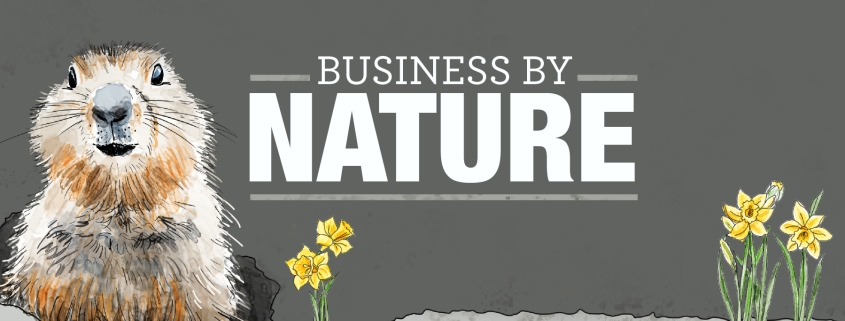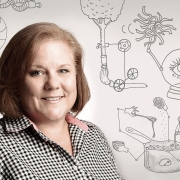Business by Nature: Weathering Hard Times, Hog Style
Groundhog-style, that is.
According to Punxsutawney Phil, we’ll be facing a few more weeks of winter this year. But seriously: why should we listen to Phil, anyway? I mean, what does a chubby, furry, nose-wiggling, “whistle pig” (as it’s known, in certain locales) know about winter weather?
A lot, actually.
Winter is where groundhogs (like Phil) really come into their own as innovators. Facing harsh conditions where resources are scarce and prospects are grim, they’ve embraced a number of unique strategies that allow them to minimize their investment of time and energy to stay “in operation.” In fact, they almost sound like…
Savvy business owners.
Yeah, the business of groundhoggin’. And Phil will be the first to tell you: slow seasons happen. But instead of seeing these “lean” periods as problems, you can embrace the opportunity to minimize your overhead while planning and preparing to hit the ground running (or, “chubbily scurrying,” in Phil’s case) when the climate is right.
So, here are five business lessons that groundhogs (i.e., whistle-pigs, land beavers, dirt-digging woodchucks) can teach us about getting through hard times and slim pickings.
Can ya’ dig it? Because, you know… groundhogs. They dig? Sigh…
![]() Prepare for the off season in the active season.
Prepare for the off season in the active season.
During the warm months, groundhogs pack on the pounds when they can—they can eat more than a pound of vegetation in one sitting. That’s like an average-sized human eating a 15-pound steak in one meal. In fact, a groundhog can more than double its body weight as it prepares for winter.
If you have a seasonal business, this is a no brainer. But, for most of us, it’s harder to predict when tough times are coming. So, when business is good, it behooves us entrepreneurs to make the most of it—because you’ll definitely want that extra “fat” if business slows.
![]() Find the perfect “brand burrow” and hunker down.
Find the perfect “brand burrow” and hunker down.
For a groundhog, a good burrow is everything. It’s what they depend on for warmth through long winters, protection from opportunistic predators, not to mention a safe space to train new “recruits” (er… babies). Diligent groundhogs will even engineer “spy holes” in their burrows to help them stay vigilant to potential threats.
If you run a business, you might think of your “burrow” as your brand—something you depend on to keep your competitive point of difference clear and compelling, even in tough times. And, just like the ever-vigilant groundhog, always be on the lookout for threats and competition looking to challenge your market position.
![]() Conserve resources when “business” is slow.
Conserve resources when “business” is slow.
Winter is a time of scarcity for groundhogs. So, instead of wasting resources in the futile pursuit of diminishing returns, they retreat to their burrows and hibernate, conserving calories and greatly reducing energy consumption. As their metabolism slows, a ‘hog’s heart beats only 4–10 times per minute.
Can you hibernate your business? Many companies embraced this strategy during COVID. But, regardless, we all know it takes a dollar to earn a dollar. So, when there are fewer dollars to be earned… take a hint from the ‘hogs; stop spinning your wheels, refocus and regroup. And if your brand has a strong “burrow” (see above), it will definitely help you make it through the “cold” times.
![]() Start chasing prospects as soon as you can.
Start chasing prospects as soon as you can.
While groundhogs actually breed in March, male groundhogs wake up early—in February—to start prospecting for potential mates. They get out there, get to know their “market” and set themselves up for success before the growing season even starts.
So, be on the lookout for signs of change as the market in your industry “wakes up.” Being first, being proactive and being relevant to needs of your customers/consumers will pay dividends as you begin to get back to “business as usual” after a downturn.
![]() Prioritize right.
Prioritize right.
Groundhogs run an efficient operation. They know what they need, and only pursue opportunities that help sustain them for the long run. They prioritize calorie-rich vegetation (like dandelions, roots and fruits), and they don’t even bother drinking water—because the vegetation they consume provides all the moisture they’ll need.
Are you pursuing leads that will sustain your business in the long term? Building strong relationships with clients you can depend on is always critical for any business—but it’s especially critical in lean times. Chasing one-off sales and deals may seem potentially lucrative—but there’s staying power in long-term clients.
So… how have you navigated these challenging times over the past few years? Any thoughts? Any tips, tricks or insights you’d like to share? We’d love to hear from you!
And if you’re looking to build a brand burrow to help keep you warm during ANY weather… we’d love to help!
#hoglife
Interested in more insightful parallels about ecology and economy? Stay tuned for the next “eco collab” from Dr. Cindy Smith and Matt Donahue.
Dr. Cindy Smith, PhD, is an award-winning educator, environmental scientist, adventure wizard and corporate sustainability consultant. As an Environmental Science and Policy professor at George Mason University, Dr. Smith has dedicated her career to making knotty ecological problems easier to understand for the public and K12, while helping build strong partnerships between corporate interests and environmental groups.
IG @cindywahoo drcindysmith.com
Matt Donahue is a Creative Director at Seed Strategy with a passion—and a penchant—for product innovation, marketing theory, brand strategy, clutch alliteration and well-timed em-dashes. Not to mention the occasional fragment. Matt is a graduate of Seton Hill University’s “Writing Popular Fiction” master’s program and writes whenever he can.
Connect with us! Follow Seed Strategy on LinkedIn, Twitter, Facebook and Instagram.













Trackbacks & Pingbacks
[…] Can Teach Us About Branding, Why Cicadas Are Nature’s Most Industrious Innovators and Weathering Hard Times, Hog Style—and be sure to stay tuned for the next “eco collab” from Dr. Cindy Smith and Matt […]
Comments are closed.